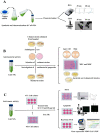Smaller Copper Oxide Nanoparticles have More Biological Effects Versus Breast Cancer and Nosocomial Infections Bacteria
- PMID: 33773555
- PMCID: PMC8286693
- DOI: 10.31557/APJCP.2021.22.3.893
Smaller Copper Oxide Nanoparticles have More Biological Effects Versus Breast Cancer and Nosocomial Infections Bacteria
Abstract
Background and objectives: Despite promising successes in developing new drugs and pharmaceutical biotechnology, infectious diseases and cancer are still the principal causes of mortality and morbidity globally. Therefore, finding effective ways to deal with these pathogens and cancers is critical. Metal nanoparticles are one of the new strategies to combat bacteria and cancers.
Methods: We examined the antimicrobial activity of 30 and 60 nm copper oxide nanoparticles (CuO-NPs) against Acinetobacter baumannii and Staphylococcus epidermidis bacteria responsible for nosocomial infections in standard and clinical strains and anti-cancer activity against 4T1 cell line as malignancy breast cancer cells. Synthesis of CuO-NPs was performed by a one-step reduction method and confirmed by DLS and TEM microscopy at 30 and 60 nm sizes. The antibacterial and anti-cancer activities of the nanoparticles were then investigated against the aforementioned bacteria and breast cancer.
Results: Using disk, well, MIC, MBC methods, and viability/bacterial growth assay, 30 nm CuO NPs were found to have more antibacterial activity on standard and clinical strains than 60 nm CuO NPs. On the other hand, using MTT, apoptosis, and gene expression method, 30 nm nanoparticles were found to have more anti-cancer potential than 60 nm CuO NPs.
Conclusions: Our findings implicate CuO-NPs to possess antimicrobial and anti-cancer effects and more significant potential in smaller sizes, suggesting their pharmaceutical and biomedical capacity.<br />.
Keywords: Acinetobacter baumannii; Copper oxide nanoparticle; Staphylococcus epidermidis; breast cancer; nosocomial infections.
Conflict of interest statement
The authors declare no conflict of interest.
Figures







References
-
- Abbasi A, Kukia NR, Froushani SMA, Hashemi SM. Nicotine and caffeine alter the effects of the LPS-primed mesenchymal stem cells on the co-cultured neutrophils. Life Sci. 2018;199:41–7. - PubMed
-
- Abbasi A, N Pakravan, ZM Hassan. Hyaluronic acid optimises therapeutic effects of hydrogen peroxide-induced oxidative stress on breast cancer. J Cell Physiol. 2021;236:1494–1514. - PubMed
-
- Albanese A, PSTang , WC Chan. The effect of nanoparticle size, shape, and surface chemistry on biological systems. Ann Rev Biomed Engin. 2012;14:1–16. - PubMed
-
- Ali K, Q Saquib, B Ahmed, et al. Bio-functionalized CuO nanoparticles induced apoptotic activities in human breast carcinoma cells and toxicity against Aspergillus flavus: An In vitro approach. Proc Biochem. 2020
MeSH terms
Substances
LinkOut - more resources
Full Text Sources
Other Literature Sources
Medical
Molecular Biology Databases

